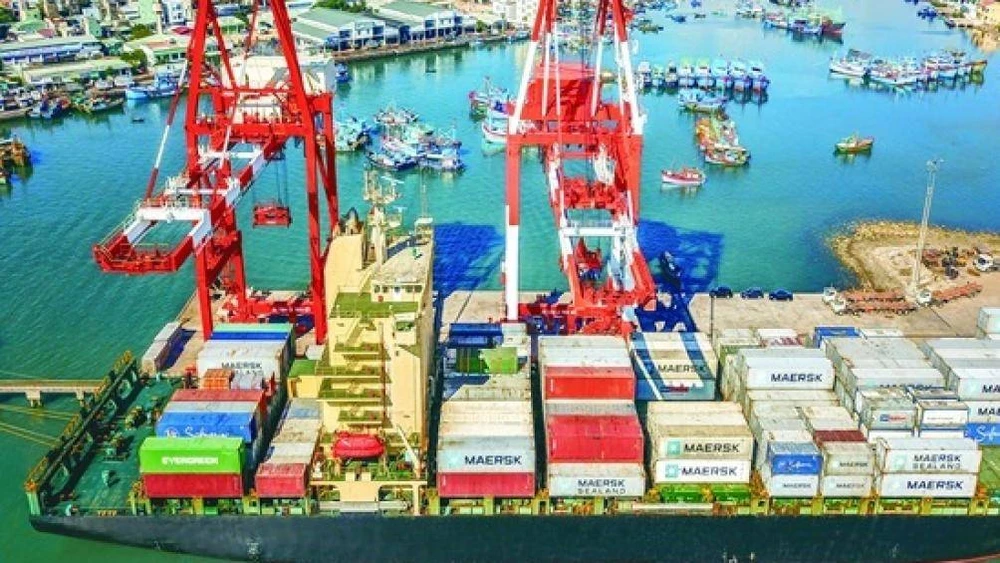
In particular, the role of seaports has been stressed as vitally crucial and the key to the growth of the maritime industry in the Central Region of the country. However, the development of seaports needs a very large investment.
Inadequate infrastructure
Included in the development plan for Vietnam's seaports from the year 2020 with orientation until 2030, fourteen groups of seaports are planned for the Central Region, including eight Type-I ports belonging to the national port authority, such as Nghi Son (Thanh Hoa), Nghe An, Ha Tinh, Thua Thien-Hue, Da Nang, Dung Quat (Quang Ngai), Quy Nhon (Binh Dinh) and Khanh Hoa ports. Among these, the port cluster of Chan May, Da Nang, Chu Lai, Dung Quat and Quy Nhon is considered the ‘backbone’ of the region. The most significant will be the roles of Da Nang, Dung Quat and Quy Nhon ports.
So far, the huge advantage to develop the ports in the Central Region has not been fully exploited or promoted. There is even a conflict of interest and constant competition among localities with seaports, leading to undermining their potential advantages. Although the Central Region have an advantage of deep-sea ports, with a large volume of cargo, container volume is limited and goods are not diverse, being mainly petroleum, cement, steel, textiles, leather shoes, wood and wooden furniture. The shipping services are still underdeveloped and have not taken full benefit of the deep-sea ports to develop on logistics and shipping in the East-West economic corridor. Shipping costs are also higher than in other regions, while management in some ports are overlapping, resulting in uneven spread of investments and development capabilities.
At the Central Economic Development Conference held in August in Binh Dinh, the Minister of Transport, Nguyen Van The, said that in recent times a number of channels into the harbor such as Cua Lo, Cua Viet, Quy Nhon are being renovated. Some other ports such as Nghi Son, Cua Lo, Da Nang (Tien Sa port phase 2), Dung Quat, and Quy Nhon are investing and rebuilding. In addition, Nghi Son general and container port is raising the capacity to 13.5 million tons; Cua Lo to 5.5 million tons; Tien Sa, Son Tra-Da Nang to 9.1 million tons; Dung Quat to 5 million tons and Quy Nhon port to 8.6 million tons.
Currently, the Ministry of Transport is preparing to invest in expanding Lien Chieu port-Da Nang channel. But, according to Minister Nguyen Van The, the expressway system has still not been synchronized, and the "fishbone" roads have also not been synchronized or connected. This interrupts the coordination between different modes of transport such as by road, railway, waterway, sea and air. In particular, connectivity of seaports and railways is limited, while some ports connected to national highways face difficulties, such as those that have to connect through inner city areas.
Weak local industry
Tran Dinh Thien, former director of the Vietnam Economic Institute, said that in exploiting and developing the potential of seaports, the central authority should pay more attention to the development of the local industries and to related logistics. If it is not associated with the local industry, it is not recommended to be in the race for investment and port development. There are a number of ports such as Da Nang, Nghi Son, Ky Ha, Dung Quat and Nha Trang that initially developed in association with fairly solid industrial development growth. However, in terms of logistic services, the Central Region still needs to be developed considerably. In addition, the Central Region needs to develop many more tourism ports connecting with coastal routes, to increase connectivity for localities.
Logistic services are essentially a multi-modal transport chain. That is, businesses providing logistics will import goods and deliver packages directly to customers, without any intermediaries. Logistics transport through many modes of transport, from roads and waterways, and businesses as well as foreign shipping lines provide very effective logistics. However, the capacity of domestic enterprises to do logistics is very limited. In general, the Central region has a lot of seaport systems, but the quality is not satisfactory. The upgrading and investment of seaports requires large capital so enterprises must join hands. The State should accompany enterprises in matters related to investment in warehouses, yards and dry ports.
-Mr. Tran Tuan Hai, Vietnam National Shipping Lines
Mr. Phan Tuan Linh has set clear goals for the next five years, in which time Quy Nhon Port will be upgraded. In particular, by 2025, the port will receive 15 million tons of cargo, raising the capacity to receive container ships up to 300,000dwt. Most importantly, the target is to improve the quality of the staff and workers to more modern day professional workers.
“In coming times, we will strengthen closer cooperation with localities and focus on clearing bottlenecks in transport infrastructure, besides improving and upgrading piers and dredging the channels. In the immediate future, we will promote the development of the auxiliary sectors, such as dry ports (consolidation and trans-shipment of goods) in mainland Binh Dinh and the Central Highlands, and increase flow of more local goods”, affirmed Mr. Linh.




















